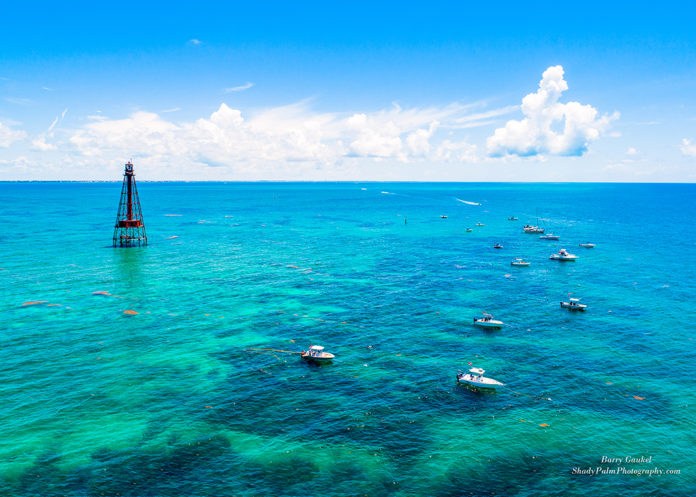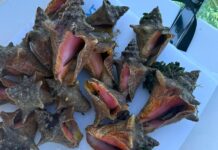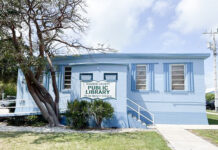
First and foremost, no one wants to blame the victim. Andrew Charles Eddy, 30, sustained a life-threatening injury when he jumped into the water at Sombrero Lighthouse on Sept. 20. No one disputes that. But photos that have appeared on social media — showing what appears to be a smooth cut, rather than a ragged tear to the front of Eddy’s shoulder — have some perplexed. The smooth cut suggests a propeller strike. And, for all the media attention shark bites receive, they are rather rare. Especially if it was a bull shark, at Sombrero, where they are rarely seen.
“The fact that the victim had lacerations on his uninjured arm, where he said he stuck it in the shark’s mouth to try to pry it open, ensures it wasn’t a prop strike. Nobody tries to put their hand in a propeller,” said Dr. Gavin Naylor, director of University of Florida’s International Shark Attack File. “We have to take this guy at his word. I don’t know what species was responsible. But it was absolutely large. The bite was very decisive. I hope this chap’s arm can be saved.”
FWC’s Capt. David Dipre said he’s seen all the photographs including the ones that show the victim’s back. “It’s absolutely a shark bite. You can see where the shark’s teeth made incisions on his back,” said Dipre. Dipre also confirmed that this type of unprovoked shark attack is very rare.
Naylor based his opinion on photos sent to him by the Keys Weekly newspaper and the account of Capt. Joe Forcine of Marathon Fire Rescue’s critical care division. Forcine rode with Eddy from Sombrero Beach, where the boat landed in haste, to the Trauma Star helicopter hangar that would airlift Eddy out of the Keys to the mainland for treatment. Forcine said if the ambulances hadn’t recently been stocked with a medicine called TXA — an intravenous coagulant used in war trauma situations — he would have bled out.
Forcine said he started asking questions of the victim, Eddy, on the way to the hangar. “I needed to understand the mechanism of the injury in order to treat it,” said Forcine, adding that the man was far too traumatized emotionally and physically to concoct a falsehood on the spot. Forcine said Eddy was face down on the stretcher when he called for Forcine to crouch down so Eddy could look him in the eye and tell Forcine what happened.
“He looked me in the face. He told me it was the scariest thing that has ever happened to him. He was petrified; I could see the fear in him. He certainly convinced me,” Forcine said.
Eddy told Forcine he jumped in the water and immediately saw a gray shape. The shark bit him almost head on by the shoulder and then started to shake and thrash him and turn him upside down. Panicking, he tried to get his other hand in the shark’s mouth. Forcine added that he confirmed the lacerations (not prop cuts) on the correct hand. “Then the shark just let go,” Forcine said.
Eddy’s pregnant wife watched it all happen and told Forcine the same story later, from her own perspective. She told Forcine that she jumped in the water and pulled him back to the boat. One of the other family members aboard, possibly a mother or sister, was a trained nurse. The boat proceeded immediately to Sombrero Beach where it was met by three ambulance teams.
Forcine said Eddy’s scapula (shoulder blade) was broken and the top of the humerus (upper arm bone) was also broken. “The typical horseshoe-shaped shark bite is visible, but only from an aerial perspective from above Eddy’s head. “The trauma was consistent with the shaking and breaking and a pressure wound.”
Forcine, a recreational diver, said he’s seen a shark approach a spearfisherman in just the same manner, only to be warded off with the tip of a speargun.
“I believe that chap was hit by a shark,” said Naylor, the director of the International Shark Attack File. “That said, like other diving colleagues have said, this is unusual. It’s atypical. This bite shows an enormous amount of force. Lots of sharks will start with a warning bite; or they bite down and adjust to fit more of the prey in their mouth and there are multiple puncture bites. Certainly, it took a large animal to cause that much force.”
“I’ve been here since 1995 and I am not aware of any unprovoked encounters like this one,” Dipre said. He said he’s seen minor shark injuries that occur when sharks are “fished up” and bite anglers, or divers who see a shark lying on the bottom and attempt to ride it by grabbing the fin.
The International Shark Attack File has only 17 unprovoked shark attacks in Monroe County on file in the past 138 years, dating back to 1882. (Sombrero Lighthouse is slightly older. It was constructed in 1858.)
Ben Daughtry of Florida Keys Aquarium Encounters said he, too, is thankful the shark bite victim survived the incident and that is the most important part of this tale. He also said that although he doesn’t visit Sombrero Lighthouse often, when he does, the fish swim right up to the boat. He said while it is illegal to chum (throw food overboard) in a Florida Keys National Marine Sanctuary SPA (Sanctuary Preservation Area), that doesn’t mean it doesn’t happen.
“There is likely feeding going on based on the fish behavior,” Daughtry said. “That is highly unusual behavior to have happened without some other circumstance involved. And I’m not saying the boat with the victim aboard did it; it could have been someone else or even some other time.”
Daughtry said he spearfishes often. Then, and only then, are the sharks curious or aggressive.
“It typically only happens when I’m swimming with dead fish,” he said.
Wendy Hall of Tilden’s Scuba Center in Marathon says she is following this story closely. In her professional career, she’s made thousands of dive trips to the Sombrero Lighthouse Sanctuary Preservation Area.
“First of all, we are all extremely thankful that the man is alive thanks to the fast thinking and actions and response of local law enforcement and medical professionals,” she said. “But the activity of feeding fish at the reef designated for swimmers only needs to be stopped immediately. And people need to be fined.”
Dipre, the FWC captain, said he is not aware of visitors feeding fish at Sombrero Lighthouse.
“There is no evidence of that and there have been no citations written,” he said.
Finally, Hall said she’s worried about the public’s perceptions of sharks. While it’s not her favorite thing, she has encountered them on deeper dives in other areas of the Keys while spearfishing and never at Sombrero Lighthouse.
“We can’t have over-reacting individuals taking it upon themselves to rid the area of bull sharks,” she said.



















